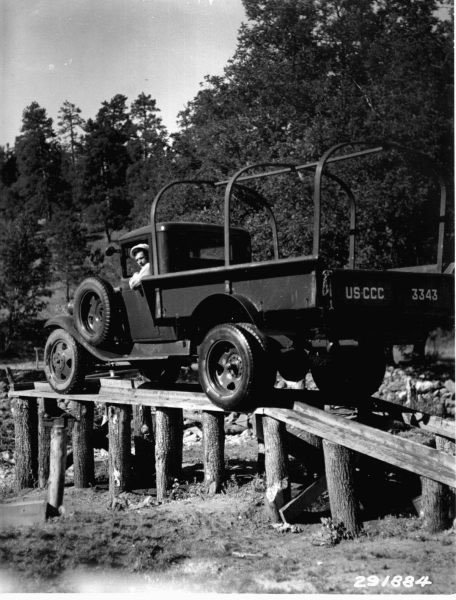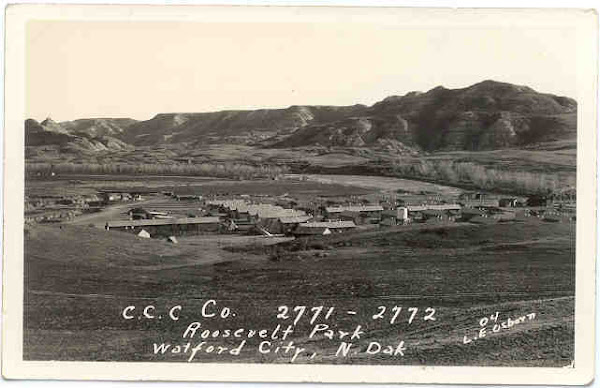 The official investigation reveals a number of factors
played into the tragedy, not the least of which was the fact that the vehicle
assigned for the task was an ungoverned Chevrolet coach, bearing U.S C.C.C.
number 76-670. “Ungoverned” means that
the accelerator on the Chevy was not equipped with the usual limiter device
that would prevent its being operated above a set speed. Governors were used to rein in the youthful
CCC enrollee operators; keeping them below an established speed. The Chevy coach assigned to enrollee Rankin
was not equipped with a governor.
Enrollee Rankin was evidently sent on his mission with an admonition
regarding the ungoverned condition of the Chevy and Rankin reportedly assured
his supervisor that he “would use every precaution, and that he was thoroughly
capable of handling the job, and that he had a driver’s license…”
The official investigation reveals a number of factors
played into the tragedy, not the least of which was the fact that the vehicle
assigned for the task was an ungoverned Chevrolet coach, bearing U.S C.C.C.
number 76-670. “Ungoverned” means that
the accelerator on the Chevy was not equipped with the usual limiter device
that would prevent its being operated above a set speed. Governors were used to rein in the youthful
CCC enrollee operators; keeping them below an established speed. The Chevy coach assigned to enrollee Rankin
was not equipped with a governor.
Enrollee Rankin was evidently sent on his mission with an admonition
regarding the ungoverned condition of the Chevy and Rankin reportedly assured
his supervisor that he “would use every precaution, and that he was thoroughly
capable of handling the job, and that he had a driver’s license…”No one will ever know for certain what made the Chevrolet in which Rankin and Phillips were riding wander onto the right hand shoulder of the road as it travelled westbound just short of a mile outside Imlay, Nevada. The investigating officials speculated that a gust of wind might have pushed the car suddenly to the right, or that an oncoming vehicle may have crossed into the lane in front of them. In any event, the car in which Rankin and Phillips were riding veered off the right shoulder of the road, travelling 641 feet before veering back across the pavement, running a distance of 224 feet before veering off the left shoulder of the highway. The investigating officials noted that the vehicle did not appear to be in a severe skid at this point and that the tracks on the south side of the highway indicated the driver was trying to pull the car back onto the blacktop when the car jumped some 40 feet, landing on all four wheels before bounding into a series of as many as four rolls before landing upright, facing roughly due north and back toward the direction of Winnemucca.
Enrollees Rankin and Phillips were thrown clear of the rolling Chevrolet, and based upon the position of their bodies, based on their injuries and damage to the interior of the Chevy and based on the location of Rankin’s glasses found at the scene, investigators determined that Rankin was very likely not at the wheel at the time of the accident.
It seems then, that Enrollee Rankin turned ungoverned Chevrolet coach U.S. C.C.C. number 76-670 over to Enrollee Phillips for the drive back to Reno. The record does not indicate whether Enrollee Phillips had a valid driver’s license and we will never know if Rankin advised Phillips that the Chevy in which they were driving was ungoverned. Likewise, we will never know why the driver change took place or even if it took place at all. Perhaps Rankin was tired from having driven from Reno to Winnemucca. Perhaps Phillips simply talked Rankin into turning over the keys. What we do know is that Enrollee’s Phillips and Rankin would never arrive back at Reno, Nevada and they would never see their dependent families back home. We also know that the lack of a governor may have played a role in the tragedy. The accident investigation found that on the Reno to Winnemucca leg of the trip, Enrollee Rankin is estimated to have averaged roughly 30 miles per hour, while on the final two hours of the tragic return trip, the vehicle averaged 52 miles per hour. Finally, we also know that three months after Phillips and Rankin died on a lonely stretch of road near Imlay, Nevada, the United States was at war with Japan and Germany and suddenly the whys and wherefores behind the deaths of two CCC enrollees in Nevada didn’t seem to matter much in the larger scheme of things.
References
Record Group 049, Box 117, National Archives and Records
Administration (NARA), Denver Colorado.
©Michael I. Smith, 2013.















